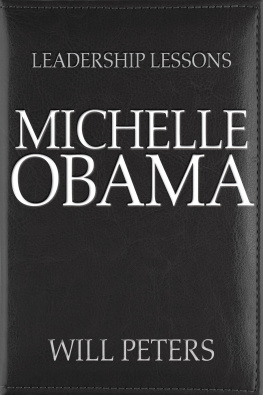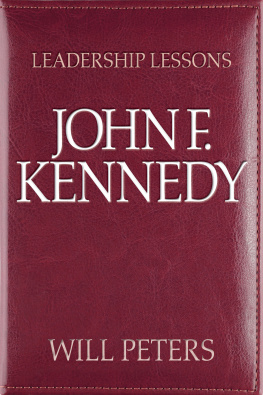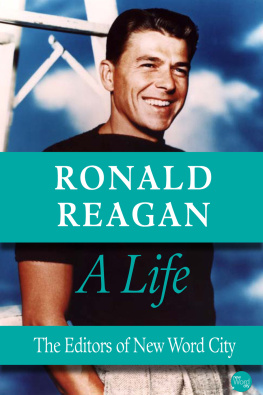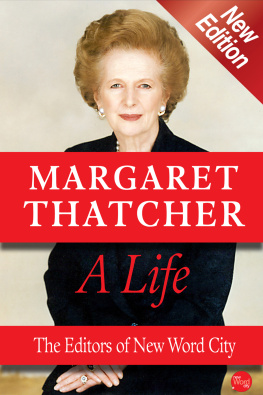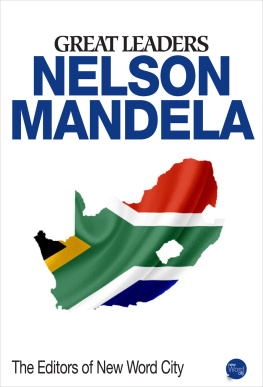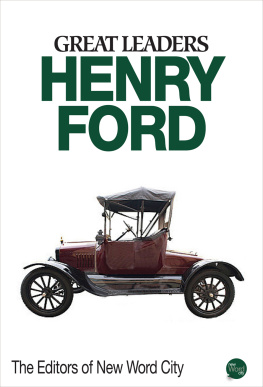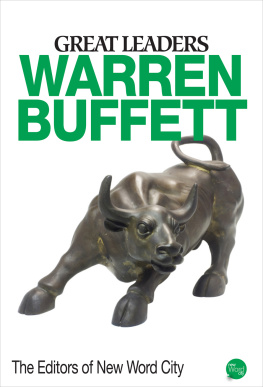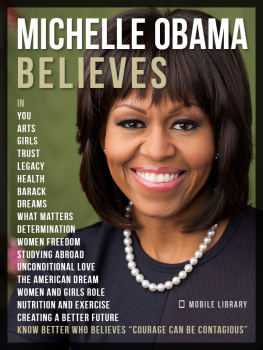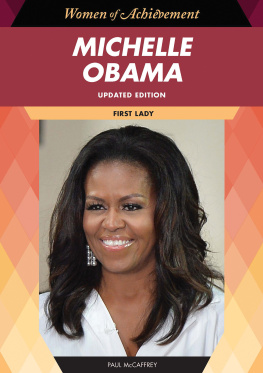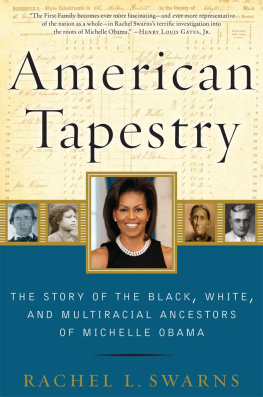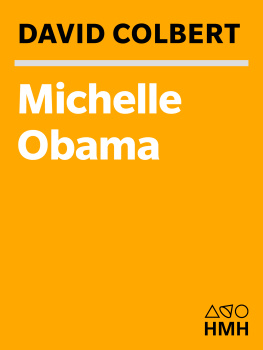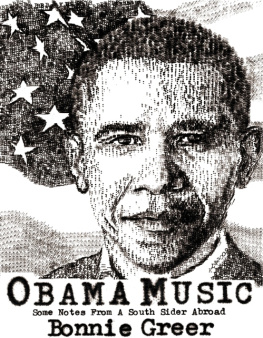Its the summer of 1860 on the Friendfield plantation in Georgetown, South Carolina - coastal low country where fields infested with snakes and mosquitos produce half of Americas rice crop. A young slave by the name of Jim Robinson labors there. Owned by another man, Robinson has no rights, no choices, no opportunities. Its hard to imagine that his dreams include a vision of his great-great-granddaughter as First Lady of the United States, living in the White House, an inspiration to her own country, and one of the most admired women in the world. But it happened. Her name is Michelle Obama - and we can be sure that Jim Robinson would be as proud of her as she is of him.
After the Civil War, Robinson became a sharecropper on the plantation. He married and, in 1884, had a son, Fraser, who lost an arm to an infection when he was ten. A local white man became fond of the boy and got permission from his family to raise him. Although he didnt send Fraser to school, his own children went, and education was stressed in the household. This made a lasting impression on Fraser, who grew up to be a successful small businessman, and education has been a cornerstone of the Robinson family ever since.
Character Comes First
Eventually, the Robinsons moved to Chicago, settling in on the citys South Side. Michelles father, the great-grandson of Jim Robinson, worked for the citys water department, tending a boiler. Her mother left her job and stayed at home until Michelle was in high school. Marian and Fraser were loving parents. Fraser had been a gifted athlete as a boy but was diagnosed with multiple sclerosis in his twenties. He never complained about his fate, but it made him even more determined to see his children succeed, and to some extent, he lived vicariously through their accomplishments. The Robinson family was all about education and discipline.
Craig was undeniably the young star of the family, bright and charming, able to ace tests with little study. (A former bond trader, he was also the mens basketball coach at Brown and Oregon State universities and is now an executive with the Milwaukee Bucks.) There was a hint of sibling rivalry, with Michelle in his shadow, and she had to study hard to earn her good grades and her fathers approval. But it paid off - in the sixth grade, she joined a gifted class at her elementary school. She went on to Whitney Young Magnet High School, Chicagos first magnet high school, a commute that took ninety minutes each way. She took advanced placement classes, was a member of the National Honor Society, and graduated in 1981 as salutatorian.
Craig went to Princeton University, and Michelle followed him there. One of the more conservative Ivy League schools at the time, Princeton was overwhelmingly white and wealthy. It was a significant adjustment for a young woman from the inner city. I remember being shocked by college students who drove BMWs. I didnt even know parents who drove BMWs, she told Vogue. There was a subtle attitude among many white students that their black classmates were affirmative-action recipients who didnt genuinely deserve to be there. The school held a special orientation for African-American and Hispanic freshmen, but it only served to reinforce their sense of being outsiders.
Michelle was acutely sensitive to the racial tension and division, so much so that she made it the subject of her senior thesis - Princeton-Educated Blacks and the Black Community. The paper has never been published, but, according to Newsweek, Michelle wrote, My experiences at Princeton have made me far more aware of my blackness than ever before and that she felt like a visitor on the supposedly unbiased campus. Regardless of the circumstances under which I interact with Whites at Princeton, it often seems as if, to them, I will always be Black first and a student second. Michelle was part of an in-between generation of successful African Americans - post civil-rights movement but before real acceptance. In some ways, this time was particularly difficult for these best and brightest because they were facing far more subtle expressions of prejudice. Her full acknowledgment and analysis of this truth is revealing of her character: Michelle Obama is a one-woman truth squad.
Two other aspects of Michelles character came to the forefront at Princeton. Her confidence was on display when she challenged the way the school taught undergraduate French. She argued for a more conversational approach. And her practical, results-oriented attitude was evident in the way she worked to level the playing field for less fortunate children - not by running for student government, but by helping to run a literacy program for children from local neighborhoods.
All in all, Michelles time at Princeton was a success - she graduated cum laude with a B.A. in sociology and was accepted at the Harvard Law School. Her pattern continued there. While she took part in demonstrations calling for the hiring of more minority professors, she also worked quietly to recruit more African-American students. She wasnt given to soaring rhetoric or self-aggrandizement. One of her professors, Charles Ogletree, has confirmed that for Michelle, politics wasnt about inspiration, it was about results. She was diligent and hardworking and earned her law degree in June 1988.
Michelle had no shortage of job offers, and she went to work at Sidley Austin, a leading corporate law firm in Chicago. Her salary was impressive, and she was on her way to becoming a partner. But something was missing from the dry trademark and copyright cases she handled. I didnt see a whole lot of people who were just thrilled to be there, she told Newsweek. I met people who thought this was a good life. But were people waking up just bounding out of bed to get to work? No.
Michelle considered leaving the firm, but she stayed on. In the summer of 1989, she was asked to mentor a summer associate from the Harvard Law School named Barack Obama. One day he walked up to her and said, I think we should go out. His confidence was disarming, but she initially resisted, thinking an office romance was inappropriate. He persevered, and she finally consented to come to one of his community-organizing meetings, which was being held in a church basement.
Obama delivered one of his signature inspiring speeches, this one about closing the gap between what the world was and what it could be. The die was cast. I was, like, This guy is different. He is really different in addition to being nice and funny and cute and all that, she explained. Hes got a seriousness and a commitment that you dont see every day. She remembers thinking, Well, you know, Id like to be married to somebody who felt that deeply about things.
Obama went back to Harvard, and Michelle continued at the law firm. They saw each other whenever he returned to Chicago.
Then, in 1991, two deaths rocked Michelle to the core. First, her father succumbed to complications stemming from multiple sclerosis. Then a dear college friend died of lymphoma. Michelle knew that the time had come to leave corporate law.
She resigned from the firm and began mentoring children from the South Side while she searched for a job in the public sector. For a young woman who had worked as hard as she had to reach the path to wealth, it could not have been easy to give it all up to contribute to her community.
Michelle wrote letters to non-profits and city agencies. One landed on the desk of Valerie Jarrett, deputy chief of staff to Chicago Mayor Richard Daley. Jarrett says, I interviewed Michelle, and an introductory session turned into an hour and a half. I offered her a job at the end of the interview, which was totally inappropriate since it was the mayors decision. She was so confident and committed and extremely open. Michelle was flattered by the offer but wasnt sure the job was right for her. She asked Obama, by then her fianc, to meet with Jarrett. Obama was impressed and counseled her to accept the offer. (Jarrett would later become a senior advisor to President Obama.)
Next page
